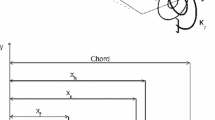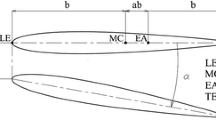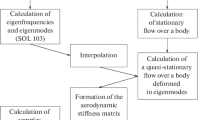Abstract
In this paper, a high-efficiency aerothermoelastic analysis method based on unified hypersonic lifting surface theory is established. The method adopts a two-way coupling form that couples the structure, aerodynamic force, and aerodynamic thermo and heat conduction. The aerodynamic force is first calculated based on unified hypersonic lifting surface theory, and then the Eckert reference temperature method is used to solve the temperature field, where the transient heat conduction is solved using Fourier’s law, and the modal method is used for the aeroelastic correction. Finally, flutter is analyzed based on the p-k method. The aerothermoelastic behavior of a typical hypersonic low-aspect ratio wing is then analyzed, and the results indicate the following: (1) the combined effects of the aerodynamic load and thermal load both deform the wing, which would increase if the flexibility, size, and flight time of the hypersonic aircraft increase; (2) the effect of heat accumulation should be noted, and therefore, the trajectory parameters should be considered in the design of hypersonic flight vehicles to avoid hazardous conditions, such as flutter.
Similar content being viewed by others
References
Yang C, Xu Y, Xie C C. Review of studies on aeroelasticity of hypersonic vehicles. Acta Aeronaut Astronaut Sin, 2010, 31(3): 1–11
Huang S Y, Wang Z Y. The structure modal analysis with thermal environment. Mis Space Vehicle, 2009, 5: 50–52
Yang C, Wu Z G, Wan Z Q, et al. Principle of Aeroelastics. Beijing: Beihang University Press, 2011. 89–91
Garrick I E. A survey of aerothermoelasticity. Aerospace Eng, 1963, 22(1): 140–147
McNamara J J. Aeroelastic and Aerothermoelastic Behavior of Two and Three Dimensional Lifting Surfaces in Hypersonic. Dissertation for the Doctoral Degree. Ann Arbor: University of Michigan, 2005. 151–160
Wu Z G, Hui J P, Yang C. Hypersonic aerothermoelastic analysis of wings. J Beijing Univ Aeronaut Astronaut, 2005, 31(3): 270–273
Chen Hao, Xu M, Cai T X. Thermal flutter analysis of hypersonic wing on transient aerodynamic heating. J Northwest Polytechn Univ, 2012, 30(6): 898–904
McNamara J J, Culler A J, Crowell A R. Aerothermoelastic modeling considerations for hypersonic vehicles. In: Proceedings of 16th AIAA/DLR/DGLR International Space Planes and Hypersonic Systems and Technologies Conference. America: American Institute of Aeronautics and Astronautics, 2009. 7397
McNamara J J, Friedmann P P. Aeroelastic and aerothermoelastic analysis in hypersonic flow: Past, present, and future. AIAA J, 2011, 49(6): 1089–1122
Culler A J, McNamara J J. Studies on fluid-thermal-structural coupling for aerothermoelasticity in hypersonic flow. AIAA J, 2010, 48(8): 1721–1738
Culler A J, McNamara J J. Coupled flow-thermal-structural analysis for response prediction of hypersonic vehicle skin panels. In: Proceedings of 51st AIAA/ASME/ASCE/AHS/ASC Structures, Structural Dynamics, and Materials Conference. Orlando: American Institute of Aeronautics and Astronautics, 2010. 2965
Yang C, Li G S, Wan Z Q. Aerothermal-aeroelastic two-way coupling method for hypersonic curved panel flutter. Sci China-Technol Sci, 2012, 55(3): 831–840
Eckert E R G. Engineering relations for heat transfer and friction in high-velocity laminar and turbulent boundary-layer flow over surfaces with constant pressure and temperature. Trans ASME, 1956, 78(6): 1273–1283
Yang S M, Tao W S. Heat Transfer. Beijing: Higher Education Press, 2007. 33–43
Lighthill M J. Oscillating airfoils at high Mach number. J Aeronaut Sci, 2012, 20(6): 402–406
Liu D D, Yao Z X, Sarhaddi D, et al. From piston theory to a unified hypersonic-supersonic lifting surface method. J Aircraft, 1997, 34(3): 304–312
Liu D D, Chen P C, Tang L, et al. Expedient hypersonic aerothermodynamics methodology for RLV/TPS design. In: Proceedings of 11th AIAA/AAAF International Conference on Space Planes and Hypersonic Systems and Technologies. Orleans: American Institute of Aeronautics and Astronautics, 2002. 5129
Watkins C E, Berman J H. On the Kernel Function of the Integral Equation Relating Lift and Downwash Distributions of Oscillating Wings in Supersonic Flow. Technical Report, National Advisory Committee for Aeronautics. 1955
Qu Z H, Liu W, Zeng M, et al. Hypersonic Aerodynamics. Changsha: National University of Defense Technology Press, 2000. 13–19
Karpel M, Presente E. Structural dynamic loads in response to impulsive excitation. J Aircraft, 1995, 32(4): 853–861
Bertin J J, Cummings R M. Fifty years of hypersonics: Where we’ve been, where we’re going. Prog Aerospace Sci, 2003, 39(6): 511–536
Karpel M. Modal-based enhancement of integrated design optimization schemes. J Aircraft, 1998, 35(3): 437–444
Qian Y J. Aerodynamics. Beijing: Beihang University Press, 2004. 260–268
Biedron R T, Rumsey C L. CFL3D User’s Manual Version 5.0, 1998. NASA-TM-1998-208444
Author information
Authors and Affiliations
Corresponding author
Rights and permissions
About this article
Cite this article
Wan, Z., Wang, Y., Liu, Y. et al. A high-efficiency aerothermoelastic analysis method. Sci. China Phys. Mech. Astron. 57, 1111–1118 (2014). https://doi.org/10.1007/s11433-014-5410-8
Received:
Accepted:
Published:
Issue Date:
DOI: https://doi.org/10.1007/s11433-014-5410-8




